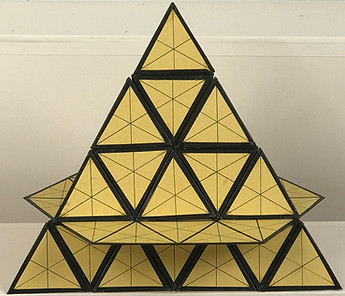Equators and Axes of Spin

Image by Byron Inouye
One of the most significant structural constants we encounter in Nature is our planet's spin around an axis that produces the Coriolis effect. This means in the northern hemisphere water draining, storms spinning or toilets flushing will always spin counter-clockwise. In the Southern Hemisphere they will spin clockwise.
In fundamental structure, the same effect applies. When you define an equator of a geometrical system (polyhedra) the northern hemisphere will spin in one direction while the southern will spin in the opposite. The equator defines the position of the axis of spin, always in 90˚ orientation to the plane of the equator.
In Newtools geometry, the axis of spin of any geometrical system will always be two blue directions from the center that pass through the north and south pole of the system. The axis of spin is helpful in comparing two systems by defining a common alignment. Most geometries place geometrical system on their side without regard to how all systems fit into one synergetic whole system. In the six systems we are examining right now, the dodecahedron and cube's axis of spin goes through outside corners instead of the center of a face. I developed small stands for physical models of these systems so all axes were aligned.




Cube/VE VE Icosahedron Dodecahedron



Cube Tetrahedron Octahedron
Naturalmodular Building Technique 'Push-Off-Start Idea'


In this section we are going to explore in detail how equators and axes of spin are interconnected. You need a context for why this is important. Naturalmodular has a push-off-start idea that needs many imaginations exploring these possible modular building patterns.
The hexagonal prism is one of the 20 systems Newtools defines as most fundamental in basic geometry. I have modified it to be a 'hexapod', a first floor base for a small modular house. Each side of the pod is a rectangle whose size is determined by what the ceiling height will be for the house, say 3 m (meters). Multiply that number by the square root of 2 to get the length.
In the example above a dodecahedron is used as a a new kind of roof where light bounces off a surface, passes through a window to be reflected across the dome-like ceiling providing soft ambient light all day. Multiple planes for placement of solar panels are possible as well. These ideas are explored in detail in the Practical Applications Portal. Understanding the interconnectedness of equators and axes of spin open up these possibilities.
Size Relative to Icosahedron

Sizes will be relative to this nesting series above.
Cube/VE Outside Containment Field



With the 9.72326...cm sized icosahedron as our standardized size we will first build a cube/VE outside containment field around it. The cube contains both the VE and the icosahedron. The numerical constant between the cube and icosahedron is GR (Golden Ratio). We know the edge of the icosa so we divide that by GR to get the edge of the square face of the cube. The edge of the outside cube 15.73257...cm.
If you divide the edge of the cube by √2 you will get the edge of the cube's hexagonal equator.
The edge is 11.12461...cm = GR(9BB). The VE has the same equator.
The axis of spin of the cube are 2 blue directions connecting the top and bottom corners; two polar caps. The axis of spin of the VE are 2 blue directions passing through the center of the top and bottom triangles; two polar caps.
Icosahedron Equator and Axis of Spin




Here you can see the value of having measurements relative to one number. The edge of the icosa 'tunes' the rest of all the measurements of the equators of the Five Platonic solids and the VE. The You/Me BB measuring system shows you the 'calculation genealogy' of each notation. It is much easier to understand the patterns going on here.
The axis of spin for the icosahedron is always 2 blue directions passing through the center of the top and bottom triangles; northern/southern polar caps.



Dodecahedron Equator and Axis of Spin





The axis of spin of the dodecahedron will always be 2 blue directions passing through the top and bottom corners; two polar caps.
Cube Equator and Axis of Spin




The cube's equator fits inside the
equator. To orient the cube's equator divide the dodeca's equator in Golden Ratio segments, GR/ .

The cube's equator edge is 3BB = 6 cm. You slice off one corner at the midpoints.
Tetrahedron Equator and Axis of Spin








There is a deep interconnectedness between the tetrahedron and the octahedron. As a pair they are allspace-filling. The equator of the tetra is at the 1/4-3/4 division instead of the usual half division. By dividing the large tetra into 1/4 volume units we see how tetra/octa pairing works. Possible modular building ideas are embedded in this relationship.
Octahedron Equator and Axis of Spin




At the core of our series of nesting structures is the 3BB octahedron. Its equator has an edge of 1.5BB.
In the Guide to the Basic Tool Box portal we explored the Pythagorean Theorem to confirm the structural constant between an icosahedron inside an octa. Here you see the pattern repeating itself with a small icosa inside this octa.

